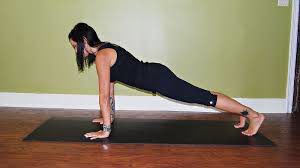Pose of the Month: Plank Pose
Pose of the Month: Plank Pose
By Gwen Lawrence
For Active.com
http://www.active.com/health/articles/pose-of-the-month-plank-pose?page=2

Share on Facebook Share on Twitter Share on Google+ Share on Pinterest
Plank pose helps build wrist and shoulder strength. Plank pose is a very basic pose used both in the yoga world and in the sports world. Although this pose looks to be an insignificant transition move, it is critical to assess your body. This pose, like several in yoga, tends to go untaught, and teachers assume students are versed in the nuances of the pose. This is a mistake. Plank pose is a great teaching tool for the student.
How to: Plank Pose
The best way to get to this pose is to start in downward facing dog. From there, press forward so your shoulders are over your wrist joint. Make sure wrists are directly under the shoulders at a 90 degree angle. The body should be in one line from the top of your head to your heels. Do not dip or raise your hips. This is the same positioning as a push up. You need to push back through your heels and forward through a neutral neck out through the top of the head. At the same time, press firmly down through your whole hand, and do not let your chest sink.
While here, make sure you have a hand that is totally engaged into the floor. Make sure hands are flat and fingers spread, with even spacing between each finger. Don’t press so firmly in this pose that you end up with a hyper-extended elbow. Then gently slide your shoulder blades down your back so your shoulders are away from your ears and your neck is elongated. Your head should be a natural extension of the spine. If you have slight pressure in the lower back, pelvic tilt until the feeling dissipates. Legs should be strong, straight and engaged. Your heels should point straight up to the sky, and your feet should be square.
Benefits of Plank Pose
Performed properly and consistently, the most noticeable benefits of plank pose include:
Strong arms, wrists, spine, quads, abdominals
Toned core
For the lay person or yogi, plank pose elongates the body and lengthens the neck. It helps the determination of a neutral body position. Building back strength counteracts the wear and weakening the back undergoes on a daily basis. Developing a strong back and abs at the same time is great for spinal support and better posture.
For the athlete, this pose is particularly important for developing wrist integrity. Wrist integrity is crucial for all athletes. Soccer players are in constant danger of falling on their wrists. Wrist power is crucial for racket sport athletes and offensive linemen, who depend of wrist strength for the success and longevity of their careers. Every athlete should be able to open their wrist to the 90 degree angle to avoid future injury and wear. Holding plank will accomplish that goal. Having your body in the plank pose with your knees off the floor gives your body weight the ability to build strength while increasing flexibility.
Plank PoseThere are a few variations to enhance the athletes’ performance. One variation is plank pose on the forearms. Instead of keeping wrists under the shoulders, have your elbows under and shoulders width apart. This variation will open an athlete’s shoulder joint. The full expression of the pose is to have the forearms parallel, which only happens if the shoulder joint is clean and open. Holding forearm plank is a great abdominal and shoulder strengthener.
Plank PoseThe other variation in this pose to further the flexibility of wrists is wrist turns. These take practice. While holding plank, turn your hands around one at a time until you can turn each wrist 180 degrees. Hold for several breaths returning the first hand to neutral position and then the second hand. It is important to make sure the turning hands wrists are still under the shoulder at 90 degrees. Watch how much heat you create in the body by holding wrist turn variation.
Although you should always consult your physician and research a properly-trained teacher before starting a yoga practice, there are a few instances where you should avoid this pose entirely:
If you have a history of carpal tunnel syndrome
If you have a history of degenerative low back problems.
NOTE: Even with a history of carpal tunnel syndrome, plank pose can help the recovery of carpal tunnel syndrome under the supervision of a highly qualified yoga teacher.
Have fun exploring this pose and learning about of your body.
